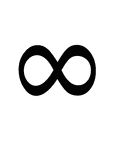Clipart tagged: ‘infinity’

Folium of Descartes
"Folium of Descartes, with its asymptote. The equation is (4-y)(y-1)2 = 3x2y ... In geometry, a plane…

Lemniscate
A Lemniscate is, in general, a curve generated by a point moving so that the product of its distances…
